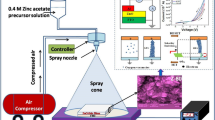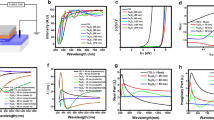Abstract
Colorless and odorless water is an important liquid element to all life on earth. In this paper, a novel resistive switching device is presented by applying a water (H2O) on titanium dioxide (TiO2) thin film based Schottky diode. The Ag electrodes are fabricated with screen printer and the TiO2 film are fabricated through a spin coater. The polydimethylsiloxane mold with holes is engineered to lock water. Applying dual voltage sweep of ± 5 V, it exhibits high resistance state of 120.6 kΩ and low resistance state of 9.4 kΩ with 100 endurance cycles, and it is stably and consistently operated for long retention tome of 104 s with Roff/Ron ratio of 12.82. From the results, we can say that liquid based materials can be used to fabricate resistive memory devices.







Similar content being viewed by others
References
L. Chua, Memristor: the missing circuit element. IEEE Trans. Circuit Theory 18, 507–519 (1971)
J.J. Yang, M.D. Pickett, X. Li, D.A.A. Ohlberg, D.R. Stewart, R.S. Williams, Memristive switching mechanism for metal/oxide/metal nanodevices. Nat. Nanotechnol. 3, 429 (2008)
S. Gao, C. Song, C. Chen, F. Zeng, F. Pan, Dynamic processes of resistive switching in metallic filament-based organic memory devices. J. Phys. Chem. C 116, 17955–17959 (2012)
A. Wu, S. Wen, Z. Zeng, Synchronization control of a class of memristor-based recurrent neural networks. Inf. Sci. 183, 106–116 (2012)
C. Li, M. Hu, Y. Li, H. Jiang, N. Ge, E. Montgomery, J. Zhang, W. Song, N. Dávila, C.E. Graves, Z. Li, J.P. Strachan, P. Lin, Z. Wang, M. Barnell, Q. Wu, R.S. Williams, J.J. Yang, Q. Xia, Analogue signal and image processing with large memristor crossbars. Nat. Electron. 1, 52–59 (2018)
T.D. Dongale, K.P. Patil, S.R. Vanjare, A.R. Chavan, P.K. Gaikwad, R.K. Kamat, Modelling of nanostructured memristor device characteristics using artificial neural network (ANN). J. Comput. Sci. 11, 82–90 (2015)
C.L. He, F. Zhuge, X.F. Zhou, M. Li, G.C. Zhou, Y.W. Liu, J.Z. Wang, B. Chen, W.J. Su, Z.P. Liu, Y.H. Wu, P. Cui, R.-W. Li, Nonvolatile resistive switching in graphene oxide thin films. Appl. Phys. Lett. 95, 232101 (2009)
G. Hassan, S. Ali, J. Bae, C.H. Lee, Flexible resistive switching device based on poly(3,4-ethylenedioxythiophene):poly(styrene sulfonate) (PEDOT:PSS)/poly(4-vinylphenol) (PVP) composite and methyl red heterojunction. Appl. Phys. A 123, 256 (2017)
M.U. Khan, G. Hassan, M.A. Raza, J. Bae, Bipolar resistive switching device based on N, N′-bis(3-methylphenyl)-N, N′-diphenylbenzidine and poly(3,4-ethylenedioxythiophene):poly(styrene sulfonate)/poly(vinyl alcohol) bilayer stacked structure. Appl. Phys. A 124, 726 (2018)
S. Ali, J. Bae, C.H. Lee, Printed non-volatile resistive switches based on zinc stannate (ZnSnO3). Curr. Appl. Phys. 16, 757–762 (2016)
K.-D. Liang, C.-H. Huang, C.-C. Lai, J.-S. Huang, H.-W. Tsai, Y.-C. Wang, Y.-C. Shih, M.-T. Chang, S.-C. Lo, Y.-L. Chueh, Single CuOx nanowire memristor: forming-free resistive switching behavior. ACS Appl. Mater. Interfaces 6, 16537–16544 (2014)
W. Wang, G.N. Panin, X. Fu, L. Zhang, P. Ilanchezhiyan, V.O. Pelenovich, D. Fu, T.W. Kang, MoS2 memristor with photoresistive switching. Sci. Rep. 6, 31224 (2016)
M.U. Khan, G. Hassan, M.A. Raza, J. Bae, N.P. Kobayashi, Schottky diode based resistive switching device based on ZnO/PEDOT:PSS heterojunction to reduce sneak current problem. J. Mater. Sci. 30, 4607–4617 (2019)
G. Hassan, M.U. Khan, J. Bae, Solution-processed flexible non-volatile resistive switching device based on poly[(9,9-di-n-octylfluorenyl-2,7-diyl)-alt-(benzo[2,1,3]thiadiazol-4, 8-diyl)]: polyvinylpyrrolidone composite and its conduction mechanism. Appl. Phys. A 125, 18 (2018)
H.-J. Koo, J.-H. So, M.D. Dickey, O.D. Velev, Towards all-soft matter circuits: prototypes of quasi-liquid devices with memristor characteristics. Adv. Mater. 23, 3559–3564 (2011)
Q. Sheng, Y. Xie, J. Li, X. Wang, J. Xue, Transporting an ionic-liquid/water mixture in a conical nanochannel: a nanofluidic memristor. Chem. Commun. 53, 6125–6127 (2017)
J.-S. Park, J.K. Jeong, H.-J. Chung, Y.-G. Mo, H.D. Kim, Electronic transport properties of amorphous indium-gallium-zinc oxide semiconductor upon exposure to water. Appl. Phys. Lett. 92, 072104 (2008)
D.E. Yates, S. Levine, T.W. Healy, Site-binding model of the electrical double layer at the oxide/water interface. J Chem Soc 70, 1807–1818 (1974)
S. Tappertzhofen, I. Valov, T. Tsuruoka, T. Hasegawa, R. Waser, M. Aono, Generic relevance of counter charges for cation-based nanoscale resistive switching memories. ACS Nano 7, 6396–6402 (2013)
T. Tsuruoka, K. Terabe, T. Hasegawa, I. Valov, R. Waser, M. Aono, Effects of moisture on the switching characteristics of oxide-based, gapless-type atomic switches. Adv. Funct. Mater. 22, 70–77 (2012)
S. Rahbarpour, S.M. Hosseini-Golgoo, Diode type Ag–TiO2 hydrogen sensors. Sens. Actuators B 187, 262–266 (2013)
E. Gale, TiO2-based memristors and ReRAM: materials, mechanisms and models (a review). Semicond. Sci. Technol. 29, 104004 (2014)
G. Hassan, J. Bae, M.U. Khan, S. Ali, Resistive switching device based on water and zinc oxide heterojunction for soft memory applications. Mater. Sci. Eng. B 246, 1–6 (2019)
K. Harrison, J.I. Levene, Electrolysis of Water, in Solar hydrogen generation: toward a renewable energy future, ed. by K. Rajeshwar, R. McConnell, S. Licht (Springer, New York, 2008), pp. 41–63
Acknowledgements
This work was supported by the National Research Foundation of Korea (NRF) Grant funded by the Korea government (MSIP) (2016R1A2B4015627 and 2019R1H1A2086726).
Author information
Authors and Affiliations
Corresponding author
Additional information
Publisher's Note
Springer Nature remains neutral with regard to jurisdictional claims in published maps and institutional affiliations.
Electronic supplementary material
Below is the link to the electronic supplementary material.
Rights and permissions
About this article
Cite this article
Khan, M.U., Hassan, G. & Bae, J. Resistive switching memory utilizing water and titanium dioxide thin film Schottky diode. J Mater Sci: Mater Electron 30, 18744–18752 (2019). https://doi.org/10.1007/s10854-019-02227-7
Received:
Accepted:
Published:
Issue Date:
DOI: https://doi.org/10.1007/s10854-019-02227-7




